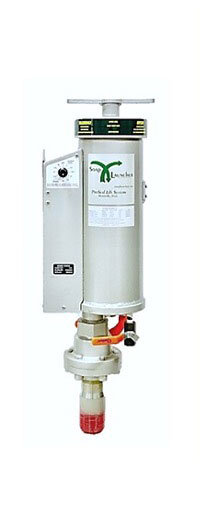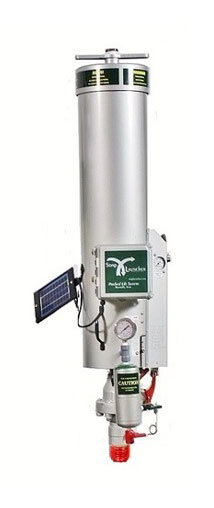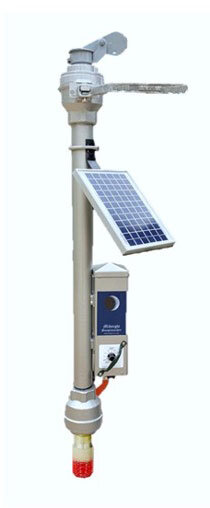The Pro-Seal Lift Systems Soap Stick Launcher can and will pay for itself in short order when used in the correct application. The ROI can be 60 to 120 days. When the Field Engineer is reviewing potential candidate wells, several factors should be taken into consideration for optimum performance:
Water
Excess water in the well bore can overcome bottom hole pressure reducing the lifting potential of the well. As the well ages, the BHP decreases, necessitating some method of artificial lift. The more quickly a de-watering program is initiated, the better the ultimate recovery will be. A well that has begun to ‘slug’ is overdue for surfactant treatment.
Surfactant dissolved within the produced water reduces the surface tension of the water molecule – promoting the formation of mist within the tubing. This lightweight mist is more easily carried to the surface by the up-flowing gas stream. Introducing soap sticks is the quickest, easiest, and most economical solution for de-watering a gas well.
Location
The well in your company’s inventory that receives limited attention due to its distance from other wells is a prime candidate for an automatic Soap Stick Launcher.
Compression
Unlike Plunger Lift and stop-cocking, the use of an automatic Soap Stick Launcher will even out the flow of gas across the meter run. A more consistent flow is a major benefit in those fields with marginal compressor capacity.
Increase
The best candidate is the well that will respond aggressively to a foamer routine. The Soap Stick Launcher will return an investment quickly and help pay for other improvements in the field.
Example: An Operator in South Texas installed a Soap Stick Launcher on a 600 MCFD well, and set it to drop 8 sticks/day. The well began producing 1000 MCFD and paid for the installation in less than 5 days. The average ROI is 60 to 120 days, depending on the price of natural gas. The target increase is on the order of 10 to 15%.
Testing
A candidate well should be soaped by hand for a few days to judge the response. If the production at the chart falls off after 3 or 4 hours, then the Soap Stick Launcher can be programmed for one stick, four times a day. After a week of using the Soap Stick Launcher, the frequency of soap used can be scaled back to conserve soapstick cost. When a fall in production is noted, the operator can re-adjust to the optimum soapstick routine.
Swabbing
Some wells, on a cap-string system, must be swabbed back in occasionally. These locations can be converted at that time to the Soap Stick Launcher.
Relocating
The Soap Stick Launcher can be easily relocated to a new well as conditions require. Light weight and compact, the Soap Stick Launcher doesn’t require expensive equipment for an installation as it can be easily relocated by one or two men.
Choosing the Best Launcher for the Job
All Launcher versions drop soap sticks based on time or on the command of an RTU. All versions can control flow from the well if the appropriate valve is installed in the flow line. The EE is 40% less expensive than the P or E but the EE is less flexible. The EE has a Dial Processor with a limited range of settings whereas the P and E are infinitely programmable, for flow and off time, up to 99 hours.
If the ambient temperature is freezing but not in a climate that demands heat tape, the Model E and Model EE are not as prone to associated issues as the pneumatic-actuated P model would be.
Available in a 9 or 18 stick version
9 Position Dial-n-Go Processor – 2.5 to 48 hours cycle time
Emissions-free 12v Electric Actuation
Scada ready with a pre-programmed 1minute launch delay feature
ABV-Control Module-ready with10 shut-in duration options
Pre-programmed for launch delay using an ABV-CM
Higher cold tolerance versus the Model P
Lowest sticks-per-unit cost
No gas supply pressure required
9 or 18 stick option
Keypad with Digital Display – 1 minute to 99 hour cycle time options
Program to drop 1 or more sticks each cycle (useful for certain horizontals)
Programmable temperature lockout
Displays the quantity of sticks remaining
Emissions-free 12v Electric Actuation
Scada ready – will wait on the RTU to initiate a stick-drop
ABV-Power Module-ready – 1 minute to 99 hour shut-in duration options
Programmable for venting to the tank via ABV-Power Module or other electric valve
Programmable Launch Delay setting, an asset for weaker locations
Controls the flow from the casing and/or the tubing in most any combination
More options, more flexible than the Model EE
Ideal for low pressure gathering systems
9 or 18 stick option
Keypad with Digital Display – 1 minute to 99 hour cycle time options
Option of dropping 1 or more sticks each cycle
Programmable temperature lockout
Displays the quantity of sticks remaining
Gas operated actuation – ready to control Kimray type motor valves
Requires 35 PSI from the tubing or casing source
Scada ready – will wait on the RTU to initiate a stick-drop
Flow Control – 1 minute to 99 hour shut-in duration options
Programmable for venting to the tank through a 2nd pneumatic motorvalve
Programmable for direct flow from the casing through a 2nd pneumatic motorvalve
Programmable for long term Launch Delay setting, helpful when pressure build up is required
Displays error messages and activity history
Includes a self-dumping drip-pot to protect the soapsticks and the control system
Smart enough to predict regulator clog failure and flag the operator
Comparisons Continued
How do the other 2 Launchers compare to the EE, E and P versions?
The M-2 Midnight Launcher holds 2 sticks only and drops them both at the same time. It can be loaded with the larger 1-5/8” diameter stick which, together, is the surfactant equivalent of 3 of the standard 1-1/4” soapsticks. The M-2 can operate an ABV in the flowline to shut-in the well. It has 7 hourly setting options and is the Launcher with the lowest cost.
The Model 9EE-HL Launcher is an M-9EE sitting atop a lower chamber. The -HL is not offered with an 18 stick capacity. The purpose of the lower chamber is to isolate the soapsticks from exposure to line pressure when the line pressure exceeds 350 psi. The maximum permissible line pressure for the M-9EE-HL is 1000 psi.




